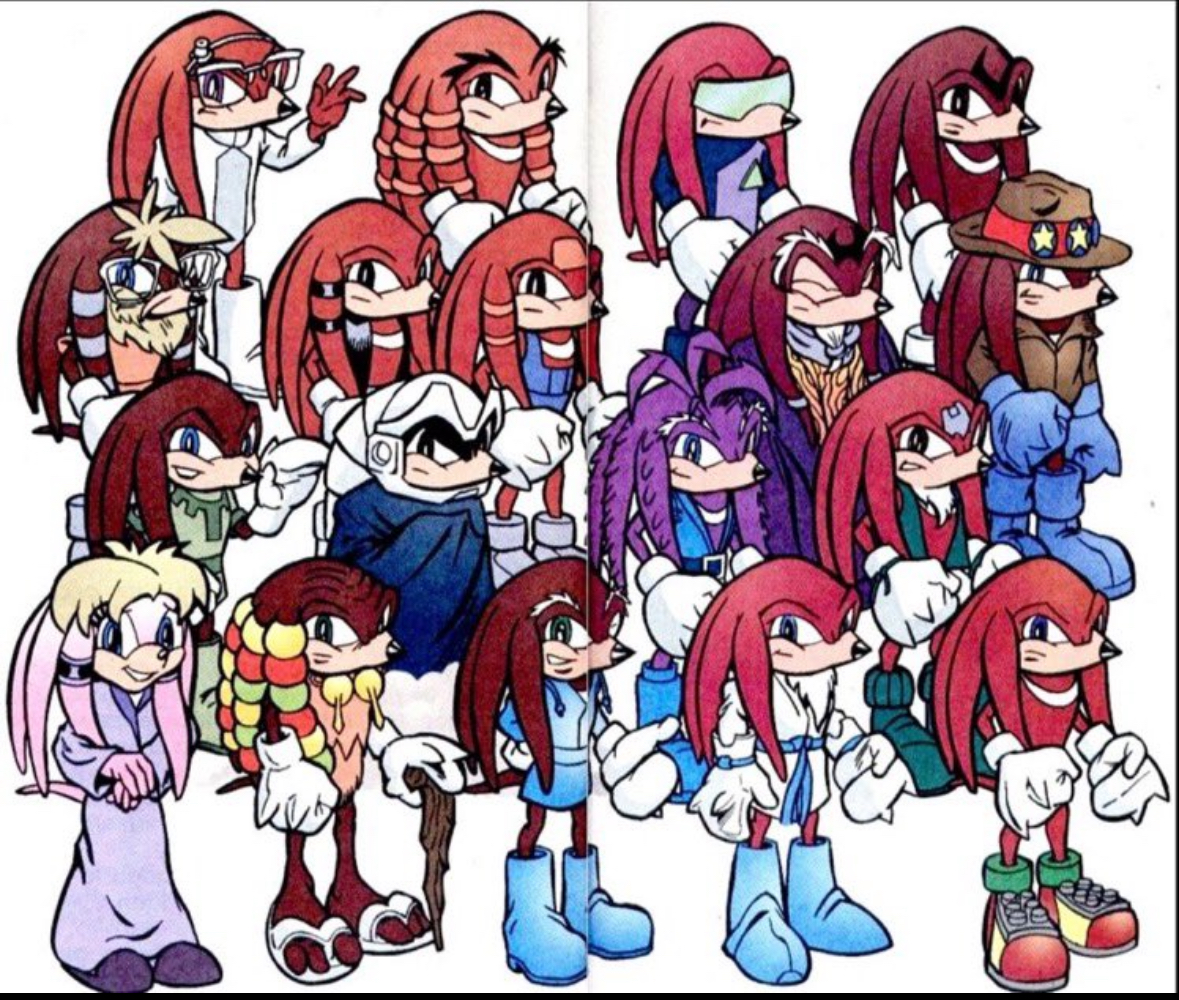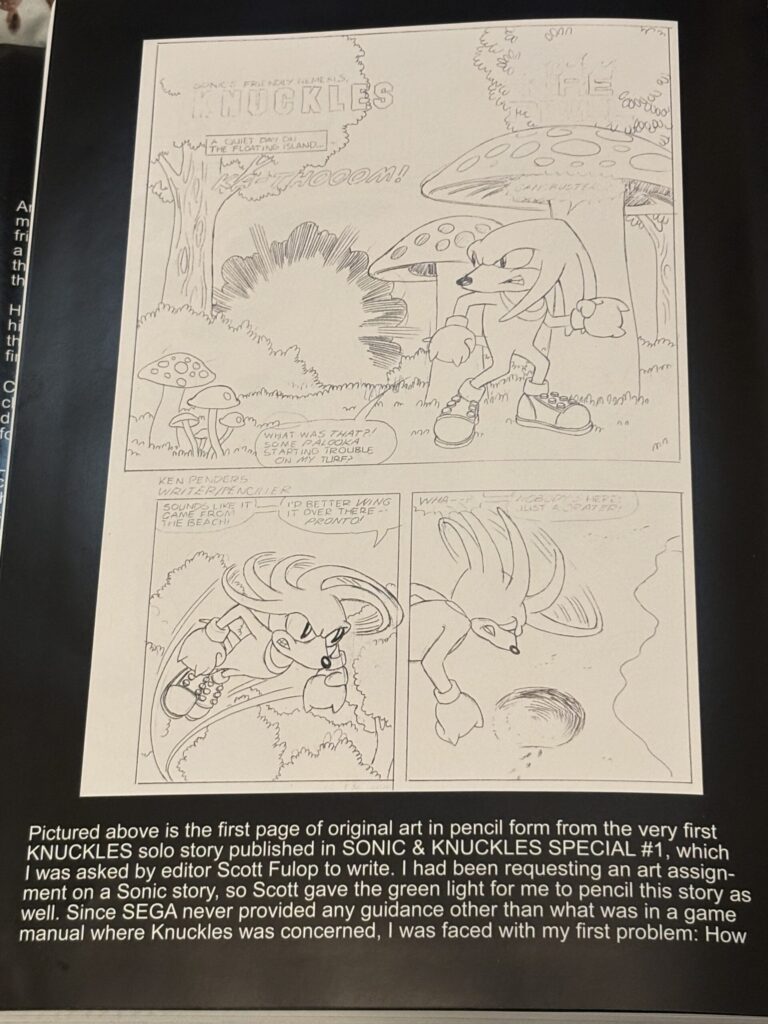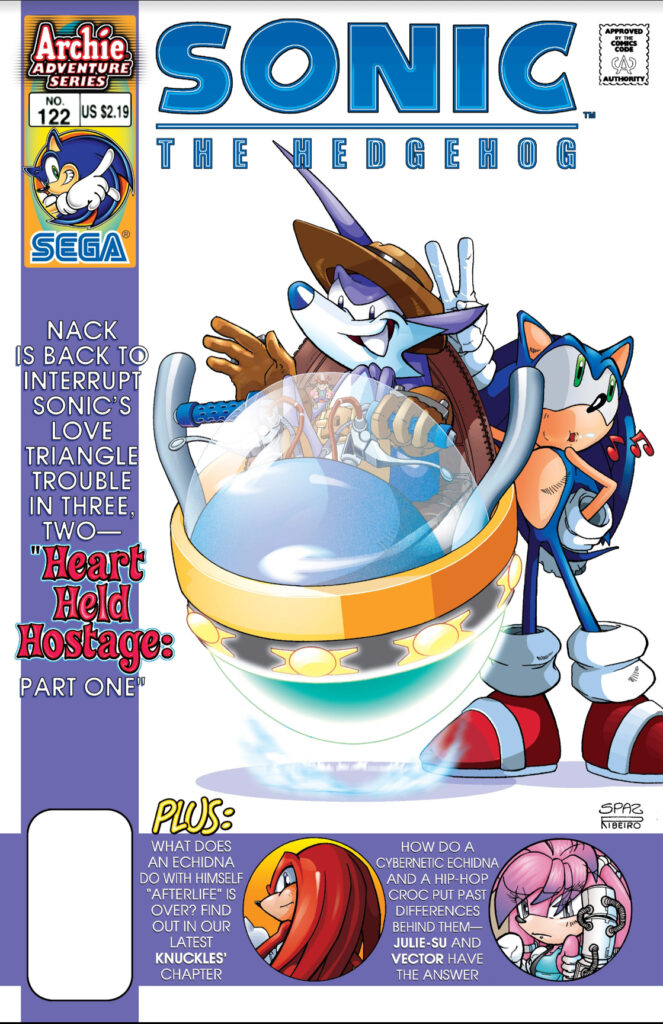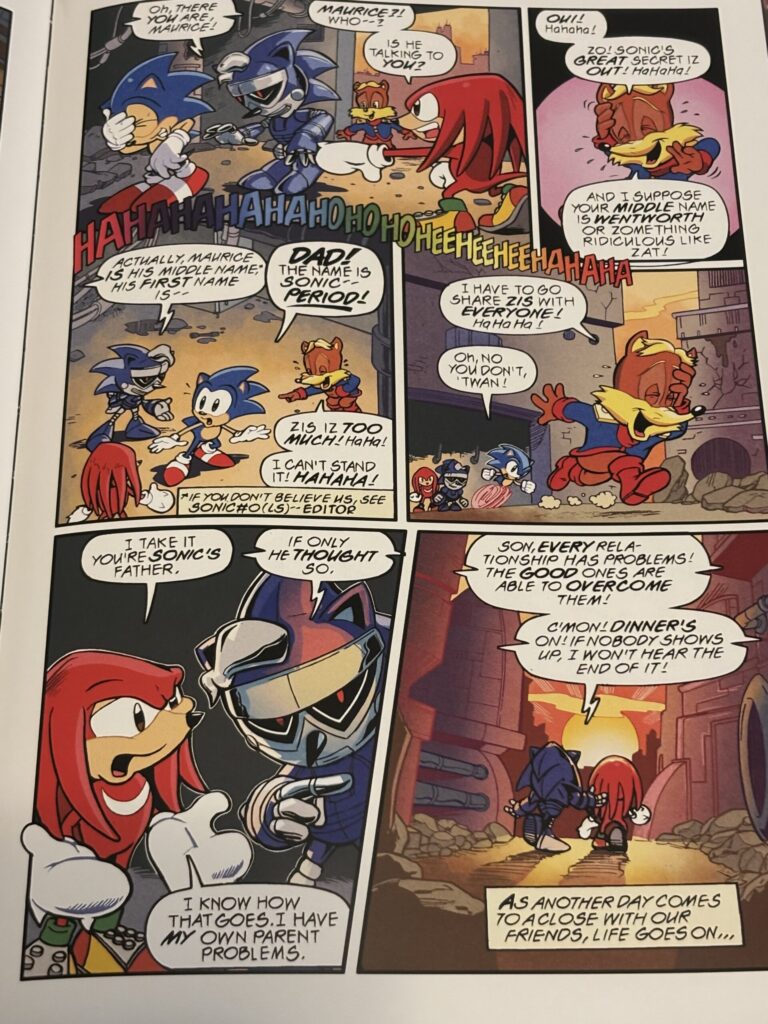


Ken Penders’ long-awaited Mobian Comics Series line has launched with the large “Knuckles the Echidna” Omnibus Volume 1. This product is the result of two decades of lawsuits, allowing Ken Penders to retain control of comics featuring a character that he turned from a two dimensional platforming game sprite into a full fledged character. Penders’ tenure on Archie’s Sonic and Knuckles comics has always been controversial. His assertive approach to creators rights placed a wedge between supporters of Penders and his letters column critic turned replacement Ian Flynn.
For fans of the pre-2006 Sonic, when Sonic lore was still in its formative phase under creator Yuji Naka in Japan, as well as Ken Penders and his co-writer Mike Gallagher in America, this collection represents a nostalgic return to a primordial Knuckles. The volume is loaded with bonus pages, including sketches showing how Knuckles as a comics character developed. One early prototype page shows Penders originally drew Knuckles flying through the air with his dreadlocks, spinning them like Tails spins his tails to fly. A caption notes that he was told to revise this, leading to Knuckles’ flight instead being powered by Chaos Emerald energy. This began the dark connection of Knuckles to chaos energy.

Early Knuckles fanart and cosplay are reprinted on one page, alongside an Archie mailing address saying to send more. It is surprising of Penders to include this blurb, given Archie has long since lost the rights to not only his characters, but the Sonic license itself.
Photos of Ken and his colleagues at Archie panels from Comic Cons line the backgrounds of Ken’s 9 page introduction. He used this space to detail the circumstances of his coming to work on Sonic and Knuckles comics, and rebut this collection’s foreword by long time Sonic fan Daniel Drazen for its criticism of Knuckles’ father Locke. Penders dedicates the book to his father, who he describes as “the Locke to my Knuckles.” Penders’ introduction acknowledges Locke is a controversial figure in Sonic fandom and that Locke’s approach of parenting was modeled after Ken’s own father. Daniel Drazen says he can’t forgive Locke’s “sink or swim” attitude, while Ken justifies Locke’s actions saying that his father dropped him in the deep end to teach him to swim.
Penders starts off his introduction saying he originally wanted to be a Star Trek artist, Sonic was at such an early stage of development that he leaped at the chance to write for a comic based on his son’s favorite games, knowing it would make him happy to read comics written by his dad about his favorite characters.
Sonic began as a lighthearted gag comic, based as much on the Adventures of Sonic the Hedgehog slapstick comedy syndicated cartoon as the dark cyberpunk Saturday morning cartoon. The comic went from short slapstick comedy stories to full length action adventure stories gradually. By issue 50, the Saturday morning cartoon was cancelled, due to Dic selling art cels without informing or compensating Sega. Penders was told to wrap the story up as the comic was probably ending soon. Instead, the Endgame arc, meant to kill Robotnik and Sally and end the story, proved very popular. Sally was quickly revived, but Penders and new co-writer Karl Bollers were allowed to keep Robotnik dead for a couple years before reviving him as a robot.
The new Sonic era was called Brave New World, and created an entire new mythos distinct from the status quo of the cartoon. The house of Acorn came to be a well defined royal dynasty with a divine right of kings, through their connection to the crown and sword of Acorns and the holy waters of the Source of All. Tails was declared by his uncle Merlin to be the chosen one. Sonic comics came to be populated with wizards like Athair and Mammoth Mogul. World building occurred with new settings like Iron Dominion and Knuckles’ Angel Island receiving as much focus as traditional settings Knothole and Robotropolis.
Over time, Sonic and Knuckles comics went from comedy to Arthurian legend to focusing more on romance, and even briefly school. Sonic became a true Archie comic with Mina Mongoose and Sally Acorn as the Betty and Veronica to Sonic’s Archie Andrews. For half a year, covers were even designed to mimic supermarket tabloids about the royals, where Archie traditionally sold many issues. Early 2000s Sonic comics featured melodramatic sagas like “Heart Held Hostage,” a two part story with art by former fan artist turned pro J Axer, about Mina taking a bullet to protect Sally from Nack the Sniper. Gossip blurbs about Knuckles’ green form or his journeys in the afterlife, and his relationship with former Dark Legion member Julie-Su, appeared at the bottom of each cover, promoting backup stories usually appeared beneath an illustration of the Sonic story of the issue.

Nowhere is the family space opera element of Penders more apparent than the Knuckles comic’s replacement as the Sonic B-feature: Mobius 25 Years Later, the future story all about how Sonic, Tails, and Knuckles fall apart as they grow up, get married, and assume responsibilities. Drazer’s foreword critiques this story as quintessential Penders, describing it as a failed experiment in “cli-fi” (climate fiction) storytelling about the end of the world where characters face an impending collapse of reality manifesting in ominous weather, yet are too consumed in personal drama to do anything about it. Notable for running an entire year without a single action sequence, this storyline is Penders’ favorite and the springboard for his new Lara-Su Chronicles comics. Yet Drazen also acknowledged M25YL contained the same character driven storytelling that drew him to Sonic comics.
Eventually Penders’ run at Archie came to an end with issue 159 of Sonic. He had creative differences with Archie’s new editor Mike Pellerito requiring rewrites on his Mobius 25 Years Later conclusion. The last straw was his difficulties coordinating with Sega of Japan on the Shadow the Hedgehog adaptation. Sega began restricting Archie from allowing Sonic to show so much emotion, as backlash to the cover of issue 156 where Sonic is crying holding an invitation to Sally and Antoine’s wedding. A heavily rewritten and redrawn version of Penders’ planned conclusion of M25YL, removing Sonic’s tears, was eventually released in issues 166-167 and credited to the new creative team Ian Flynn and Tracey Yardley. These issues were omitted from the M25YL reprint in Lara-Su Chronicles Beginnings, but are announced for inclusion in the Shadow Files reprint.
After Penders had a falling out with Ben Hurst over negotiations with Sega over their proposed film continuation of Hurst’s Saturday morning Sonic cartoon, Penders and Larry Houston pitched a film called Sonic Armageddon to Sega. Like Sonic Live, Penders featured his children playing Sonic as a plot element of the story. None of these film projects came to fruition, but Sega would eventually release a live action CGI Sonic film trilogy and Knuckles miniseries.
Penders’ decision to reclaim his characters was motivated by Ian Flynn killing off Locke in a way that contradicted Ken’s Father’s Day story. In Penders’ original Locke death, set in the futuristic timeline of Mobius 25 Years Later, Locke died of cancer, mirroring Ken’s own father’s death from pancreatic cancer. The Father’s Day two parter is widely regarded as Penders’ most moving work, and like this volume, it was dedicated to his father.
Locke’s cancer may be a byproduct of his exposure to Chaos Energy from the Master Emerald, something that also led to Knuckles’ death and rebirth in the Afterlife arc. Locke’s repeated use of Chaos Energy upon Knuckles’ egg before he hatched was designed to create the ultimate Guardian and stop a great crisis foretold to him by the Ancient Walkers in a dream. Locke then chose to divorce his wife and abandon his child outside of Echidnaopolis to guard the Master Emerald, without explaining that his people still lived in another zone. Locke’s death is critical to Knuckles’ decision to allow his daughter Lara-Su to succeed him as Guardian. Lara-Su becoming Guardian is the core arc of Mobius 25 Years Later and the ongoing continuation in Ken Penders’ Lara-Su Chronicles, which began last year with a hardcover extended reprint of Mobius 25 Years Later called Lara-Su Chronicles: Beginnings. By having Knuckles become Enerjak and kill Locke in the present, Ian Flynn turned Locke’s vision of a great disaster prevented by a savior Knuckles on its head. Penders’ endgame, revealed in a flashback in Mobius 25 Years Later, was Knuckles killing Robotnik and creating a utopia.
Penders felt personally betrayed by Flynn’s story, claiming Archie was not supposed to use his characters without his permission after leaving the title. He then copyrighted his characters, leading to a series of legal battles with Archie and Sega. After Archie failed to produce work for hire paperwork and numerous editors and writers testified that Archie’s alleged photocopy of a contract was a forgery, the court ruled it was inadmissible. Archie relented in their claims to their old characters, removing all of the comic original characters produced prior to Ian Flynn’s run. After a few years of a rebooted continuity using only new, game, and cartoon characters, Archie lost the license to Sonic to IDW.
The stories in this collection contain some of Knuckles’ earliest appearances in Sonic comics interspersed with his later solo series. While fans may lament the absence of most of Super Sonic vs. Hyper Knuckles, the most pertinent story from that special issue was reprinted. The Sonic issues have exceptionally extensive recoloring compared to the Knuckles ones, given more of a Star Wars special edition style of edit. A great deal of effort has gone into creating shading and detail that was absent in the original printings. Significant changes have been made to the artwork including characters like Tails being redrawn as well as recolored. Robots from the games have been added to the background.
Penders’ extensive revisions to the Knuckles’ family tree are even incorporated, with images of his ancestors’ floating heads being extended to add even more generations. The Lara-Su Chronicles Beginnings glossary contains 20 generations of Guardians, and we get to see them all in visual form here for the first time. The large blank Knuckles family tree activity page from the end of my first Archie Sonic comic, Sonic issue 103 may even be doable with this information.
Ken Penders has tweeted before that he planned to include Knuckles 20 Years Later in a Knuckles omnibus omnibus. Sadly, this did not eventuate in this volume. Possibly it is being reworked as part of future volumes from the Mobian Adventure Line or the Lara Su Chronicles. As well as filling the gaps between the Omnibus and Lara-Su Beginnings with more Knuckles omnibus volumes, Penders has announced plans to do Shadow, Princess Sally, and Geoffrey St. John collections. His next release is planned to be Scott Shaw’s Sonic Early Days collection, reprinting the original Archie Sonic limited series. These are pricey hardcover collections, for hardcore fans of Penders’ work.
These stories may be confusing if you are not steeped in the history of Sonic and Knuckles. Appearances written by other creators are skipped over. Only some of his appearances guest starring in Sonic game adaptations are here, like Sonic 3, Sonic & Knuckles, and Knuckles’ Chaotix. The first several solo Knuckles comic arcs are also present here, featuring the Dark Legion and the Brotherhood of Guardians’ conflict on Echidnaopolis. Knuckles starts off the volume as a random one off bruiser for Sonic to fight, but quickly develops into a character with a world as significant as Sonic’s. The crossover story from Sonic 53 that rounds out the volume assumes knowledge of the post Endgame status quo palace intrigue in the house of Acorn. It features some of the best coloring of the whole volume, and humorously ends with the infamous page where Sonic’s real name is revealed to be Wentworth Maurice Hedgehog.

Did you enjoy the digital enhancements of this reprint, or do you prefer to stick with the original issues?
Discuss this article on the Toonzone Forums!
The post Review: Knuckles Omnibus: the Revenge of the Echidnas appeared first on Anime Superhero News.